Notre-Dame de Paris I
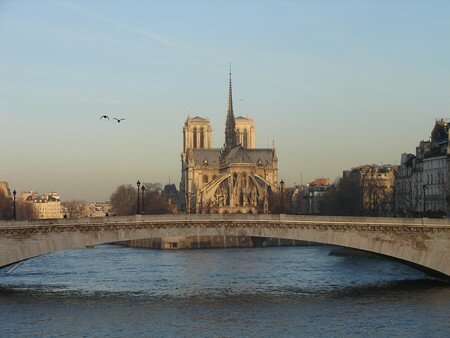 The current cathedral is not the first building built on this site.
The current cathedral is not the first building built on this site.
 Elements
carved dating from the reign of the emperor Tibère (14-37 after J-C)
and found under the chorus of the cathedral make it possible to think
that the Eastern part of the island of the City already sheltered in
Antiquity a place of worship dedicated to Gallic and Roman divinities.
Elements
carved dating from the reign of the emperor Tibère (14-37 after J-C)
and found under the chorus of the cathedral make it possible to think
that the Eastern part of the island of the City already sheltered in
Antiquity a place of worship dedicated to Gallic and Roman divinities.
 In
1711, the architects of the king, wanting to build in the chorus a
vault for the burial of the archbishops, trenched there; one excavated
up to five meters, and on March 16, the pickaxe of the workmen met,
with two meters of the ground, two old walls applied one to the other,
which crossed together all the length of the chorus; one of these walls
had one meter and half thickness, the other approximately eighty
centimetres; this one appears to have been oldest, because it was there
that one found employed, instead of rubble, nine ancient stones,
charged of low-reliefs or inscriptions.
In
1711, the architects of the king, wanting to build in the chorus a
vault for the burial of the archbishops, trenched there; one excavated
up to five meters, and on March 16, the pickaxe of the workmen met,
with two meters of the ground, two old walls applied one to the other,
which crossed together all the length of the chorus; one of these walls
had one meter and half thickness, the other approximately eighty
centimetres; this one appears to have been oldest, because it was there
that one found employed, instead of rubble, nine ancient stones,
charged of low-reliefs or inscriptions.
 These
invaluable monuments, cut in a stone similar to the tender stone of
Saint-Leu, are placed in the large room of the palate of the Thermal
baths, depend on the museum of Cluny, under the name of ``pillar of
Nautes''.
These
invaluable monuments, cut in a stone similar to the tender stone of
Saint-Leu, are placed in the large room of the palate of the Thermal
baths, depend on the museum of Cluny, under the name of ``pillar of
Nautes''.
 The
darkness which wraps the beginnings of our history also extends on the
origin of Notre-Dame. It is difficult to discover, in the middle of the
contradictory accounts which one finds in our former historians, which
was the saint or the king who threw the foundations of this church. One
meets many fictions, one loses oneself in a crowd of economic
situations. Thus, the ones claim that saint Denis posed the first stone
of the Notre-Dame church. Is this in the city, is this in the suburbs?
it is what they do not decide. Did one give him initially the name of
Notre-Dame or that of Saint-Denis of the Step? it is what they are
unaware of. However, any door to believe that the intervention of saint Denis in the construction of this church must be completely isolated.
The
darkness which wraps the beginnings of our history also extends on the
origin of Notre-Dame. It is difficult to discover, in the middle of the
contradictory accounts which one finds in our former historians, which
was the saint or the king who threw the foundations of this church. One
meets many fictions, one loses oneself in a crowd of economic
situations. Thus, the ones claim that saint Denis posed the first stone
of the Notre-Dame church. Is this in the city, is this in the suburbs?
it is what they do not decide. Did one give him initially the name of
Notre-Dame or that of Saint-Denis of the Step? it is what they are
unaware of. However, any door to believe that the intervention of saint Denis in the construction of this church must be completely isolated.
Indeed,
Gregoire de Tours teaches us that saint Denis came to Paris when this
city was yet only “Lutèce, surrounded of the Seine, located in an
island little extended, where one approaches on the two sides by
bridges out of wooden,” like known as Julien, in IIIth century, under
the impérialat of Dèce.
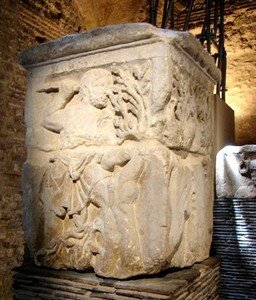 In
this time, Paris had as pontiffs the Druids; for religious ceremonies,
human sacrifices; for faith, the idolatry and the hatred of
Christianity. Denis saint and his neophytes could celebrate sacred
mysterieies only in undergrounds, in isolated places of the city,
called crypts, which one supposes to have been in the site where is the
Saint-Germain-des-Prés district: it is thus far from probable that the
Gallic ones, which would have sacrificed the Christians on the furnace
bridge of the Druids, had tolerated the construction of a catholic
church in the enclosure even of the incipient city.
In
this time, Paris had as pontiffs the Druids; for religious ceremonies,
human sacrifices; for faith, the idolatry and the hatred of
Christianity. Denis saint and his neophytes could celebrate sacred
mysterieies only in undergrounds, in isolated places of the city,
called crypts, which one supposes to have been in the site where is the
Saint-Germain-des-Prés district: it is thus far from probable that the
Gallic ones, which would have sacrificed the Christians on the furnace
bridge of the Druids, had tolerated the construction of a catholic
church in the enclosure even of the incipient city.
 In
which time the Jupiter furnace bridge was reversed? One is unaware
of it, but obviously its disappearance coincides with the introduction
of Christianity into the city; authentic titles prove that it was
replaced by a church as of the end of the IVth century. This
primitive church was rebuilt by Childebert Ist with a magnificence
which the bishop Fortunatus poet describes. In 1847, the substructions
of this splendid basilica to the marble columns were put at the day by
excavations undertaken with the Notre Dame de Paris square. The
foundations of the church of Childebert, hidden there for ten
centuries, had merged with those several Roman houses which one had
shaven to widen his site.
In
which time the Jupiter furnace bridge was reversed? One is unaware
of it, but obviously its disappearance coincides with the introduction
of Christianity into the city; authentic titles prove that it was
replaced by a church as of the end of the IVth century. This
primitive church was rebuilt by Childebert Ist with a magnificence
which the bishop Fortunatus poet describes. In 1847, the substructions
of this splendid basilica to the marble columns were put at the day by
excavations undertaken with the Notre Dame de Paris square. The
foundations of the church of Childebert, hidden there for ten
centuries, had merged with those several Roman houses which one had
shaven to widen his site.
 One
found part of the mosaic in small marble cubes of various colors whose
ground of the naves was paved, three marble columns of Aquitaine, which
one calls large antique, and a Corinthian white marble capital of
merovingian sculpture. The columns and the capital are exposed to the
museum of Cluny, which not indicates them on its catalogue like coming
from the basilica of Childebert, according to the opinion of Guilhermy,
but from the pagan temple which would have preceded this basilica. Most
complete of these columns preserved its astragale and its Corinthian
capital in the Latin style, characteristic which seems to give reason
to the catalogue of Cluny.
One
found part of the mosaic in small marble cubes of various colors whose
ground of the naves was paved, three marble columns of Aquitaine, which
one calls large antique, and a Corinthian white marble capital of
merovingian sculpture. The columns and the capital are exposed to the
museum of Cluny, which not indicates them on its catalogue like coming
from the basilica of Childebert, according to the opinion of Guilhermy,
but from the pagan temple which would have preceded this basilica. Most
complete of these columns preserved its astragale and its Corinthian
capital in the Latin style, characteristic which seems to give reason
to the catalogue of Cluny.
 This
should not surprise us, indeed, it is not rare to find vestiges of
pagan temples to the site of the current churches, the Church having
taken the practice of evangelize the populations by preserving the
localization of the old places of worship, while modifying the
direction of the step of faithful, by christianizing them.
This
should not surprise us, indeed, it is not rare to find vestiges of
pagan temples to the site of the current churches, the Church having
taken the practice of evangelize the populations by preserving the
localization of the old places of worship, while modifying the
direction of the step of faithful, by christianizing them.
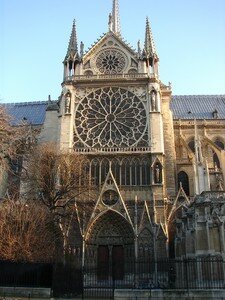 More
recent excavations made it possible to put at the day of the fragments
ancient mosaics, columns and capitals as well as capital of merovingian time and revealed the bases of an old church with five naves
built on the model of the constantinians basilicas (IVth century).
More
recent excavations made it possible to put at the day of the fragments
ancient mosaics, columns and capitals as well as capital of merovingian time and revealed the bases of an old church with five naves
built on the model of the constantinians basilicas (IVth century).
The
first church of Paris, recognized for cathedral per celebrates it
Gregoire de Tours, was located under the first current spans of
Notre-Dame, but then dedicated to Saint Etienne, the first of the
martyrs. The documents present this first cathedral to
us like having a narthex with a bell-tower-porch, glaze of wooden
carpentries. Us are described his interior like particularly luxurious,
as well by decoration as by furniture as it contained.
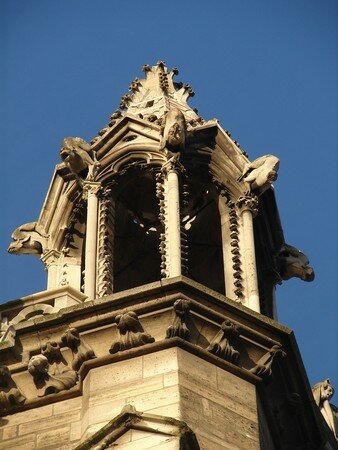 Towards
the end of the VIth century, the current site of the cathedral was
occupied by two distinct buildings: one, the Saint-Etienne, most
important, rose at midday; the other, titrated of Sainte-Marie, in the East and towards north. It is in the nave of Saint-Etienne
that was assembled, in year 829, celebrates council of Paris. In
857, whereas Paris was devastated by the Norman ones, the Énée bishop
could repurchase only Saint-Etienne and let burn Sainte-Marie. This one
was not long however in leaving its ruins and was generally indicated
under the name of new church, in opposition to that of Saint-Etienne,
which was much older. The capetians kings had taken in affection the
church of the Virgin, to which the archdeacon Étienne de Garlande, died
in 1142, made make important repairs, and to which the Suger abbot gave
a very beautiful stained glass. It was Maurice de Sully, bishop of
Paris since 1160 to 1196 and it sixty-twelfth successor of saint Denis,
who conceived the project to build a large cathedral on the site of the
two churches, by joining together them.
Towards
the end of the VIth century, the current site of the cathedral was
occupied by two distinct buildings: one, the Saint-Etienne, most
important, rose at midday; the other, titrated of Sainte-Marie, in the East and towards north. It is in the nave of Saint-Etienne
that was assembled, in year 829, celebrates council of Paris. In
857, whereas Paris was devastated by the Norman ones, the Énée bishop
could repurchase only Saint-Etienne and let burn Sainte-Marie. This one
was not long however in leaving its ruins and was generally indicated
under the name of new church, in opposition to that of Saint-Etienne,
which was much older. The capetians kings had taken in affection the
church of the Virgin, to which the archdeacon Étienne de Garlande, died
in 1142, made make important repairs, and to which the Suger abbot gave
a very beautiful stained glass. It was Maurice de Sully, bishop of
Paris since 1160 to 1196 and it sixty-twelfth successor of saint Denis,
who conceived the project to build a large cathedral on the site of the
two churches, by joining together them.
 Always
it is that at the beginning of the XIIth century, it proved to be
essential to renovate this building become decayed. The archdeacon of
Paris, Étienne de Garlande made do at the building important work in
particular a gate devoted to the Virgin who was re-installed thereafter
in the gate saint-Anne of the current cathedral.
Always
it is that at the beginning of the XIIth century, it proved to be
essential to renovate this building become decayed. The archdeacon of
Paris, Étienne de Garlande made do at the building important work in
particular a gate devoted to the Virgin who was re-installed thereafter
in the gate saint-Anne of the current cathedral.
 At the beginning of the XIIth there was already, being next to the
cathedral in north, a baptistry, Saint-Jean-the-Round, quoted in the
texts of the VIth century, as well as vast enclosed reserved for
the houses of the canons. Moreover, there was also an episcopal palate,
in the east of the island, and an hospital.
At the beginning of the XIIth there was already, being next to the
cathedral in north, a baptistry, Saint-Jean-the-Round, quoted in the
texts of the VIth century, as well as vast enclosed reserved for
the houses of the canons. Moreover, there was also an episcopal palate,
in the east of the island, and an hospital.
 In
Paris with the XIIth century, the initiator of the project is without
question the bishop Maurice de Sully. Wire of peasants of Sully on the
Loire, it did not have personal incomes to finance work, on the other
hand it managed remarkably well the ecclesiastical goods assigned to
its load (the episcopal mense) and its financial participation was
capital. Its successors: Eudes de Sully, but also of the men like
Guillaume of Auvergne or Simon Matifas de Buci will have in heart to
lead the building site to its completion or to make to the building
modifications of scale.
In
Paris with the XIIth century, the initiator of the project is without
question the bishop Maurice de Sully. Wire of peasants of Sully on the
Loire, it did not have personal incomes to finance work, on the other
hand it managed remarkably well the ecclesiastical goods assigned to
its load (the episcopal mense) and its financial participation was
capital. Its successors: Eudes de Sully, but also of the men like
Guillaume of Auvergne or Simon Matifas de Buci will have in heart to
lead the building site to its completion or to make to the building
modifications of scale.
 The
bishop was assisted in his task by the chapter, institution which since
the IXth century gathers all the canons serving the cathedral. For
lack of documents, one does not know if the chapter intervened
systematically in the financing of the building site to the XIIth
century. On the other hand, with the XIIIth century, this chapter
which has part of the episcopal mense and goods clean takes an
increasingly significant part in the management of the building site,
particularly with regard to the hospital.
The
bishop was assisted in his task by the chapter, institution which since
the IXth century gathers all the canons serving the cathedral. For
lack of documents, one does not know if the chapter intervened
systematically in the financing of the building site to the XIIth
century. On the other hand, with the XIIIth century, this chapter
which has part of the episcopal mense and goods clean takes an
increasingly significant part in the management of the building site,
particularly with regard to the hospital.
 Contrary
to certain generally accepted ideas, the king does not intervene in the
construction of Notre-Dame of Paris. Even if Louis VII made a gift
before his death in 1180, even if the royal characters knelt with the
tympanum of the ``carries Rouge'' are traditionally regarded as saint Louis and Marguerite of Provence, letting think that the royalty would
have taken part directly in the building site of Notre-Dame, it for
what we do not have any document unfortunately, the cathedral cannot be
regarded as a royal building site.
Contrary
to certain generally accepted ideas, the king does not intervene in the
construction of Notre-Dame of Paris. Even if Louis VII made a gift
before his death in 1180, even if the royal characters knelt with the
tympanum of the ``carries Rouge'' are traditionally regarded as saint Louis and Marguerite of Provence, letting think that the royalty would
have taken part directly in the building site of Notre-Dame, it for
what we do not have any document unfortunately, the cathedral cannot be
regarded as a royal building site.
 As
for the participation of the middle-class men (are middle-class those
who live inside the walls of the city), it is of a financial nature and
takes the shape of offerings; this practice of the offerings does not
make besides the unanimity among the clergy and Pierre the Cantor,
senior of the chapter about 1180, the critic highly.
As
for the participation of the middle-class men (are middle-class those
who live inside the walls of the city), it is of a financial nature and
takes the shape of offerings; this practice of the offerings does not
make besides the unanimity among the clergy and Pierre the Cantor,
senior of the chapter about 1180, the critic highly.
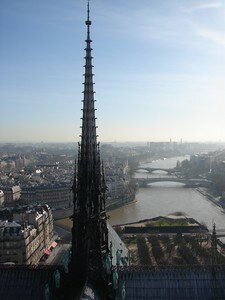 If
the financial participation of the people is quite real, its
participation in the building site concerns more of the myth than
reality. The design of such an imposing work requires the intervention
of specialists and they are specialized and organized trade
associations which work on the building site, the tasks of operations
being entrusted to men recruited on the spot and paid at the day.
If
the financial participation of the people is quite real, its
participation in the building site concerns more of the myth than
reality. The design of such an imposing work requires the intervention
of specialists and they are specialized and organized trade
associations which work on the building site, the tasks of operations
being entrusted to men recruited on the spot and paid at the day.
Among these experts, the architects are most important: true men of science, even to the title of ``main lapidaries are allotted to them. ''
Unfortunately, in Notre-Dame, we do not know the names of the first architects of the XIIth and XIIIth centuries. The first name which reached us is that of Jean de Chelles. It increases the northern transept and undertook the construction of the southern transept, but it disappeared in 1258 and it is its successor, Pierre de Montreuil, who continued work. Then came Pierre de Chelles who modified the bedside and its current aspect gave him, and Jean Ravy, who finished the chorus closure.
Ist century the Eastern part of the island of the City already
sheltered in Antiquity a place of worship dedicated to Gallic and Roman
divinities
IVth Construction of a church by Childebert
VIth Presence of two churches: St Etienne and co. Marie
829 First council of Paris
857 Destruction of co. Marie by the Norman ones
1142 Étienne de Garlande, died in 1142, made make important repairs on
St Etienne, the Suger abbot gave a very beautiful stained glass.
1163 Pose first stone of Notre Dame by Louis VII and the pope Alexandre III
1177 End of the construction of the chorus
1182 Dedication of the high altar in front of cardinal papal legate
1182 End of the construction of the nave and the transept
1196 Died of évèque of Paris Maurice de Sully, appointment of its successor, Eudes de Sully
1208 End of the construction and the decoration of the gates of the frontage
1230 Enlarging of the windows of the high part of the nave
1240 End of the construction of the southern tower - abandonment of the project of flêches on the lathes
1250 End of the construction of the northern tower and the gallery connecting the two turns
The 1258 architect Jean de Chelles takes the work management: one owes him the northern frontage of the transept
The 1265 architect Pierre de Montreuil succeeds Jean de Chelles: one owes him the southern frontage of the transept
The 1296 architect Pierre de Chelles succeeds Pierre de Montreuil
The 1318 architect Jean Ravy succeeds Pierre de Chelles: one owes him
the vaults in the north of the chorus and propping up them
The 1344 architect Jean Bouteiller, nephew of Jean Ravy, takes his continuation
The 1363 Raymond architect of the temple takes the work management
1430 Crowning of Henri VI king d' Angleterre
1455 Beginning of the lawsuit of rehabilitation of Jeanne d' Arc
1572 Marriage of Henri de Navarre, future Henri IV, with Marguerite de Valois
1638 Birth of Louis XIV. His/her father pronounces a wish then and
promises “to rebuild the Large Furnace bridge of the church cathedral
of Paris”
1699 Louis XIV entrusts to Robert de Cotte the
realization of work to respect the wish of Louis XIII. He will result
the destruction from it from jubé, the stalls and the high altar. As
for the walls, they will be whitewashed of white.
1730 Installation of the Large organ of François Thierry
1741 Continuation of work for the wish of Louis XIII: Levieil replaces the stained glasses of the chorus by white glass
1771 Soufflot destroys the pier of the central gate which obstructed the processions and prevented the passage of the platform
1783 François-Henri Clicquot undertakes the transformation of the large organ
The 1792 rioters of the revolution cut down the statues of the gallery
of the kings and make dismount the flêche - the cathedral is renamed
“temple of the Reason” then transformed into warehouse.
1802 Bonaparte restores the worship in the cathedral, consequence of the signature of the legal settlement
1804 Crown of Napoleon 1st in the presence of the pope
1831 Victor Hugo publishes Notre Dame de Paris
The 1843 architects Jean-baptiste Lassus and Eugene Viollet-the-Duke see themselves entrusting the restoration of the cathedral
1857 Died of Jean-baptiste Lassus. Viollet-the-duke takes only the work management
1864 Completion of work of restoration
1868 Restoration of the large organ of Cliquot by Aristide Cavaillé-coll
1871 Of the chairs and the benches are sprinkled with oil and are ignited. The fire is avoided of accuracy.
1970 Cleaning of the frontages
The 1977 heads of the kings of the gallery of the western frontage,
decapitated by the revolutionists in 1792, are found in under ground of
the French Bank of the trade exterior and transported to the museum of Cluny
1988 the architect Bernard Fonquernie takes the work management of restoration which continues
still

/https%3A%2F%2Fprofilepics.canalblog.com%2Fprofilepics%2F1%2F1%2F116167.jpg)
/https%3A%2F%2Fstorage.canalblog.com%2F49%2F16%2F312499%2F14620054_o.jpg)
/https%3A%2F%2Fstorage.canalblog.com%2F53%2F18%2F312499%2F14151229_o.jpg)
/https%3A%2F%2Fstorage.canalblog.com%2F07%2F05%2F312499%2F14149867_o.jpg)
/https%3A%2F%2Fstorage.canalblog.com%2F11%2F35%2F312499%2F14149307_o.jpg)
/https%3A%2F%2Fstorage.canalblog.com%2F90%2F14%2F312499%2F14125247_o.jpg)

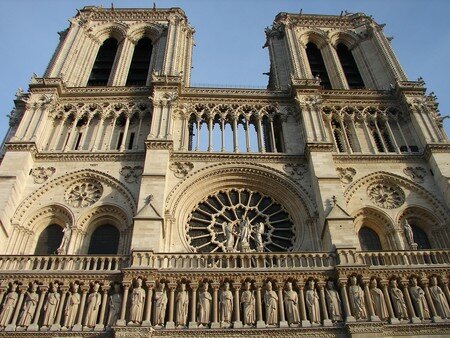


/https%3A%2F%2Fstorage.canalblog.com%2F12%2F98%2F137895%2F6624411_p.jpg)
/https%3A%2F%2Fstorage.canalblog.com%2F34%2F82%2F137895%2F27207854_p.jpg)
/https%3A%2F%2Fstorage.canalblog.com%2F32%2F37%2F137895%2F15872299_p.jpg)
/https%3A%2F%2Fstorage.canalblog.com%2F37%2F81%2F137895%2F15879822_p.jpg)